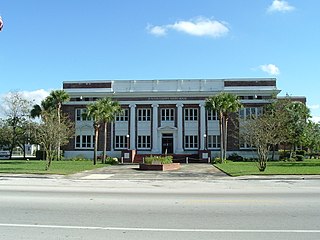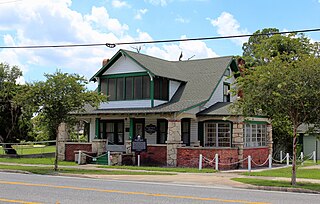
Flagler County is a county located on the northeastern coast of the U.S. state of Florida. As of the 2010 census, the population was 95,696. Its county seat is Bunnell. Created in 1917 from portions of Saint Johns and Volusia Counties, it was named for Henry Morrison Flagler, who built the Florida East Coast Railway.

Bunnell is the county seat of Flagler County Florida, United States, with a population of 2,676 at the 2010 census. The city is part of the Deltona–Daytona Beach–Ormond Beach, FL metropolitan statistical area and is named after an early resident, Alvah A. Bunnell, a shingle maker and supplier of wood to the area's fledgling rail industry.

Palm Coast is a city in Flagler County, Florida. As of the 2010 United States Census, the population was 75,180, more than twice the 32,832 counted in 2000. The population was estimated to be 89,800 in 2019. It is the most populous city in Flagler County. Palm Coast is part of the Deltona–Daytona Beach–Ormond Beach, FL metropolitan statistical area.

Palm Beach is an incorporated town in Palm Beach County, Florida, United States. Located on an island in east-central Palm Beach County, the town is separated from several nearby cities including West Palm Beach and Lake Worth Beach by the Intracoastal Waterway to its west, though Palm Beach borders a small section of the latter and South Palm Beach at its southern boundaries. As of 2010 census, Palm Beach had a year-round population of 8,348 and an estimated population of 8,816 in 2019, increasing by around 25,000 people between November and April.

The Florida East Coast Railway is a Class II railroad operating in the U.S. state of Florida, currently owned by Grupo México.

One-room schools were commonplace throughout rural portions of various countries, including Prussia, Norway, Sweden, the United States, Canada, Australia, New Zealand, the United Kingdom, Ireland, and Spain. In most rural and small town schools, all of the students met in a single room. There, a single teacher taught academic basics to several grade levels of elementary-age children. While in many areas one-room schools are no longer used, it is not uncommon for them to remain in developing nations and rural or remote areas. Examples include remote parts of the American West, the Falklands, and the Shetland Islands.
The Howard County Public School System (HCPSS) is the school district that manages the public schools of Howard County, Maryland. It is headquartered in the Columbia, Maryland census-designated place; the facility has an Ellicott City mailing address. It operates under the supervision of an elected, eight-member Board of Education. Dr. Chao Wu is the Chairman of the Board. Michael J. Martirano is the current Superintendent, replacing Renee Foose following her resignation in May 2017.

Chiefland Middle High School is a public high school in Chiefland, Florida. It is a part of the District School Board of Levy County.

The Schoolhouse Children's Museum & Learning Center is located in a historic school building, the Boynton School, at 129 East Ocean Avenue in Boynton Beach, Palm Beach County, Florida.

Redland, long known also as the Redlands or the Redland, is a historic unincorporated community and agricultural area in Miami-Dade County, Florida, United States, about 20 miles (32 km) southwest of Downtown Miami and just northwest of Homestead, Florida. It is unique in that it constitutes a large farming belt directly adjoining what is now the seventh most populous major metropolitan area in the United States. Named for the pockets of red clay that cover a layer of oolitic limestone, Redland produces a variety of tropical fruits, many of which do not grow elsewhere in the continental United States. The area also contains a large concentration of ornamental nurseries. The landscape is dotted with u-pick'em fields, coral rock (oolite) walls, and the original clapboard homes of early settlers and other historic early twentieth century structures.

Miami Senior High School is a public high school located at 2450 SW 1st Street in Miami, Florida, United States, and operated by Miami-Dade County Public Schools. Founded in 1903, it is the oldest high school in Miami-Dade County. The school building is famous for its architecture and is a historic landmark. Miami Senior High School has a rich alumni base, with many graduates of the high school going on to varied, prominent careers. The high school originally served the earliest settling families of Miami in the first half of the 20th century. By the late 1960s, with an increase in Miami's population, its student body grew at a fast pace.
Breathitt County High School is a public high school located in the city of Jackson, Kentucky nestled in the Appalachian Mountains of Eastern Kentucky. The 2009-2010 enrollment is around 520 students. The school colors are royal blue and white. The current principal is Charles Davidson, and the current assistant principal is Bonnie Lively.

Mayer Red Brick Schoolhouse is a building in Mayer, Arizona. It was listed on the U.S. National Register of Historic Places in 2004. It is considered the longest used schoolhouse in Arizona, having been in operation for over eighty years. Due to its physical mass and prominent hillside location, it is "the most visible and identifiable building" in the small unincorporated town and the town's largest building.

Isaac I. Moody Jr. was born in Appling County, Georgia and moved to St. Johns County, Florida in the early 1890s and first worked in the turpentine business as a woods rider near present-day Bunnell, Florida. He ventured into various businesses including turpentine, shingle milling, real estate and banking. After getting into politics he quickly gained influence and local and statewide respect and was instrumental in the establishment of Flagler County, Florida in 1917. He was a 32nd degree Mason, and was elected as Worshipful Master of the Bunnell Lodge No. 200 in 1918, and was a member of the Morocco Temple of Shriners at Jacksonville, FL. Today, he is remembered as the "Father of Flagler County."

The Holden House, located at 204 E. Moody Blvd., Bunnell, Florida, was built in 1918 by Samuel Merwin Bortree (1859-1918) as a wedding gift for his daughter Ethel Lura Bortree Holden (1892-1977), and her husband Thomas Edward Holden (1892-1974). It is an excellent example of the Craftsman Bungalow architectural style. The house was purchased by Flagler County for $40,000 on August 6, 1979 from a Holden family member. It is now a museum that features artifacts from Flagler County and the general Florida area dating from the St. Johns Culture to the present. It is also the headquarters for the Flagler County Historical Society. The house's upstairs bathroom was one of the first indoor bathrooms in the Bunnell area and features unique small hexagon tiles on the floor which were similar to the flooring design used in the original owner's pharmacy building which is no longer extant and was located at the southwest corner of the intersection of Moody Boulevard and U.S. 1 in Bunnell. The Holden House was listed on the National Register of Historic Places on October 16, 2018.
George Washington Carver High School was built in 1949 on 12 acres of land along Drain Street in Bunnell, Flagler County, Florida. It was a racially segregated public black-only high school during the Jim Crow era, and was in operation from 1949 to 1967.

The Bunnell Coquina City Hall is a unique one-story public building constructed of locally quarried coquina stone. The property is located at 200 South Church Street, Bunnell, FL 32110 in the downtown section of the city. It includes man-made Lake Lucille with its jetting fountain in the front of the building, which creates an impressive visual appeal to the setting of the property. It was built in 1936–1937 with grant funding from the Work Progress Administration WPA.

During the 1930s, the Flagler County, Florida Jail was in dire need of repairs and enlargement. Flagler County Commissioners were under pressure from local citizens and grand juries to repair the building or erect a new one. After months of negotiations, during 1938, between the Flagler County Board of Commissioners and the Works Progress Administration WPA an agreement to build a new Flagler County Jail building was approved. A WPA Project, No. 4242, was approved that cost approximately $24,000. It was agreed that the costs would be divided between Flagler County and the WPA. Construction of the new Flagler County Jail started January 25, 1939 under the management of Z. D. Holland, WPA Supervisor and well known local contractor. It was built on 2.04 acres of county-owned property located at 1600 Old Moody Blvd., Bunnell, FL.

The Espanola Schoolhouse is a one-story; one-room rural school building that has survived from the Jim Crow racial segregation-era. It is the last standing one-room schoolhouse in Flagler County. It is located at 98 Knox Jones Avenue, Bunnell, Florida 32110.

The Redland Farm Life School, also known as the Redland Farmlife School, is a historic former school in Redland, Florida, in southern Miami-Dade County. Opened in 1916, it consolidated seven one-room schoolhouses in the area and was at the time the second largest rural consolidated school in the country.
























